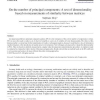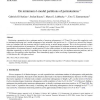570 search results - page 8 / 114 » On the number of zero-sum subsequences |
ICDM
2007
IEEE
14 years 4 months ago
2007
IEEE
We consider the problem of elastic matching of sequences of real numbers. Since both a query and a target sequence may be noisy, i.e., contain some outlier elements, it is desirab...
HOTOS
1993
IEEE
14 years 1 months ago
1993
IEEE
I argue against trying to solve the problem of clustering objects into disk pages. Instead, I propose that objects be fetched in groups that may be specific to an application or ...
DM
2008
13 years 10 months ago
2008
We determine the number of alternating parity sequences that are subsequences of an increasing m-tuple of integers. For this and other related counting problems we find formulas th...
CSDA
2008
13 years 10 months ago
2008
An important problem in principal component analysis (PCA) is the estimation of the correct number of components to retain. PCA is most often used to reduce a set of observed vari...
JDA
2008
13 years 9 months ago
2008
Partitioning a permutation into a minimum number of monotone subsequences is NP-hard. We extend this complexity result


